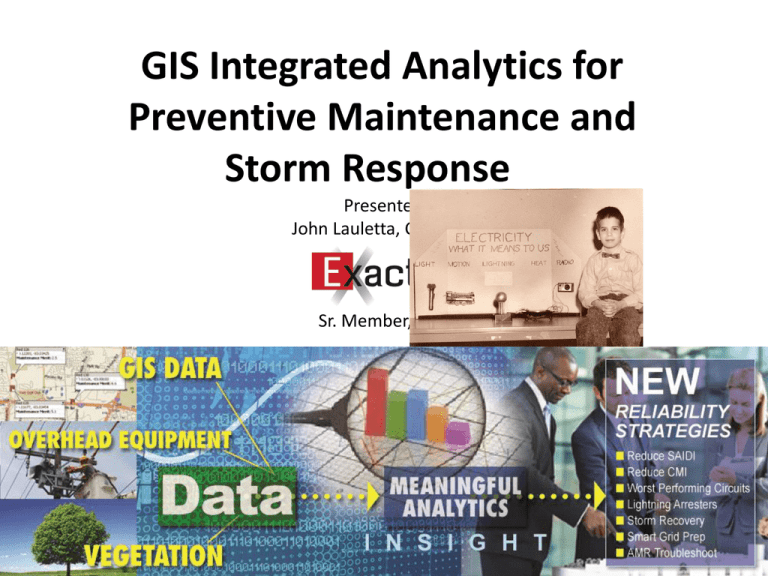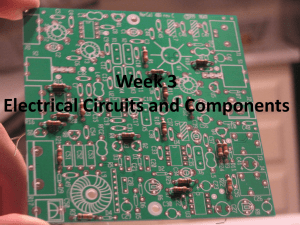Applying Predictive Maintenance presented by John
advertisement

GIS Integrated Analytics for Preventive Maintenance and Storm Response Presenter: John Lauletta, CEO/CTO Sr. Member, IEEE Preventive Maintenance Decision Process Budget Circuit Performance Non Storm-Related Outages on the Electric Distribution System Equipment Failure 31% Miscellaneous 19% Trees / Vegetation 32% Animal Contact 18% Source: U.S. DOE Preventive Maintenance Decision Process Budget Circuit Performance Grid Design Asset Health Optimized Maintenance Vegetation Mgmt. Connectivity RF Emission Detection Predictive Maintenance (PdM) Predictive Maintenance is based upon knowing the condition of equipment in a system. Predictive Maintenance means using technologies that tell us what will fail in the future, not what is failing right now. Predictions come from monitoring the condition of equipment as it is operating. Here are some ways to measure equipment condition. There are many benefits to conditionsbased maintenance including lowering cost, improving system performance and enhancing worker safety. But, how can the condition of all the equipment on the grid be measured? Measuring the Condition of the Grid Ultrasonic Emission Detection Infrared Detection Visual Detection Exacter, Inc. Provides: Grid Condition Assessment for Improved System Resiliency and Reliability Based in Columbus, OH US Strategic Partners: Int’l Alliance Partners – Australia, Mexico, Canada 2 US Patents, 7 Int’l Patents 2 million+ Poles Surveyed 3rd Party Validation – U.S. Dept. of Energy (DOE) – Nat’l Elec. Testing Lab (NETL) – The Ohio State University Research Facilities The Ohio State University High Voltage Laboratory Initial Research 2004 to 2006 Advanced Research Coninues Test Fixtures Surge Arrester Being Studied Two views of the test setup Lab Workstation Faraday Cage Research Analytics EXACTER® Sensor Exacter Acquisition and Analysis Process Data Acquisition & Discrimination Data Analysis Actionable Information Data analyzed for severity, persistence and prevalence, enabling: • Exact locating of failing component • Replacement prioritization RF emissions from arcing (deteriorated) electrical components Exacter sensor in vehicle/aircraft collects the signals and then discriminates and GPS locates arcing, tracking and leaking electrical components Precise GPS coordinates and relevant conditiondata transmitted to servers for final statistical geospatial analysis Reports and GIS compatible information provided to customer The Need: DOE Smart Grid Project Example http://www.smartgrid.gov/reports Condition Assessment: Select Circuits and Design Survey Following the selection of circuits to be included in the assessment, Exacter Data Specialists design specific survey routes using public access roadways. The EXACTER Sensor is sensitive in a 200 meter radius from the vehicle. Survey Quality Control Condition Assessment: Monitor Survey Progress While the survey is underway, the path of the survey vehicle, the WHITE trace, is monitored to insure that the circuits being assessed are completely studied. Accuracy of results is improved by multiple passes of the same route over a four week period. Condition Assessment: Real-time Failure Signature Analysis Whenever the EXACTER Sensor locates a line emission that correlates to a Failure Signature a real-time study is completed. The 986 RED markers show all of the studies from the four-week survey process. Condition Assessment: EXACTER Condition Assessment Results The 986 RED Failure Signature Events are studied by EXACTER Servers to create this result: 25 BLUE Maintenance Groups where a structure includes at least one weakened component. Analytical Process to Locate Deteriorated Equipment Internal Algorithms: Geographic Circle Calculation • Calculates coordinates of a circle which is centered about a point on the globe • Difficult cone-sphere intersection problem • Adopted a method described in The Journal of Applied Meteorology by I. Ruff in 1971 Transmission Equipment Deterioration Aerial Surveys Prioritized Maintenance Action: Select Equipment to Replace Specific component(s) that are arcing, leaking or tracking on those structures that have been prioritized for repair are identified. Photographs, Maps, Reports, and GIS Files are provided. GIS .SHP File Example: Project Design • Projects are designed with utility data to create an optimized price/benefit result • Utilities: – Set Goals – Perform Maintenance – Measure Results Outage Causes Animals and Other, 37% Equipment, 31% Vegetation, 32% Selected Priority Feeders to Assess and Improve Affecting 20% of Outages Predictive Based Maintenance Deferred, Less Critical , Low SAIDI Impact Feeders 11% Example: Prioritized Worst Performing Circuit (WPC) Improvement Program 25,000,000.00 Eastern Division CMI Impact Analysis Circuit CMI Contribution 5,950 OVHD Miles 35.0% 30.0% 30% 20,000,000.00 26% 25.0% 15,000,000.00 20.0% 17% 73% of Total CMI – 1,904 miles (32%) 10,000,000.00 CMI Result of Current Programs 9% 8% 5,000,000.00 2% 2% 1% 1 11 21 31 41 51 61 71 81 10.0% 5.0% 5% - 15.0% 91 101 111 121 131 141 151 161 171 181 191 201 211 221 231 241 251 0.0% 0% SAIDI IEEE 1366 Sum of All Customer Interruption Durations Total Number of Customers Served 71.18 61.33 63.92 23.38 Aggregate Customer Experience SAIFI Total # of Customer Interruptions Total Number of Customers Served 1.52 1.48 1.53 1.03 Aggregate Customer Experience CAIDI Sum of All Customer Interruptions Total Number of Customer Interruptions Relatively No Change in the Customer Experience 46.73 41.32 41.90 22.78 Aggregate Customer Experience Non Storm-Related Outages on the Electric Distribution System Equipment Failure 31% Miscellaneous 19% Trees / Vegetation 32% Animal Contact 18% Source: U.S. DOE Flat Response = Challenges & Opportunities 500 450 400 CAIDI 350 300 250 200 150 100 50 0 0 0.5 1 1.5 2 2.5 SAIFI 3 3.5 4 4.5 5 Flat Response = Challenges & Opportunities 500 450 400 CAIDI 350 300 250 200 150 100 50 0 0 0.5 1 1.5 2 2.5 SAIFI 3 3.5 4 4.5 5 Target Performance 500 450 400 CAIDI 350 300 250 200 150 100 50 0 0 0.5 1 1.5 2 2.5 SAIFI 3 3.5 4 4.5 5 Top Decile 20 Years of Design Excellence 500 450 400 CAIDI 350 300 250 200 150 100 50 0 0 0.5 1 1.5 2 2.5 SAIFI 3 3.5 4 4.5 5 SAIDI Focus O&M – Workforce Deployment 500 450 400 CAIDI 350 300 250 200 150 100 50 0 0 0.5 1 1.5 2 2.5 SAIFI 3 3.5 4 4.5 5 SAIFI Focus Capital Intensive Programs 500 450 400 CAIDI 350 300 250 200 150 100 50 0 0 0.5 1 1.5 2 2.5 SAIFI 3 3.5 4 4.5 5 Typical Strategies A u t o m a Tree t i o n 500 450 400 CAIDI 350 300 250 200 60% – 70% Out of ROW Trimming 150 100 50 0 0 0.5 1 1.5 2 2.5 SAIFI 3 3.5 4 4.5 5 Replace Deteriorated Equipment A u t o m a Tree t i o n 500 450 400 CAIDI 350 300 250 200 Trimming 150 100 50 0 0 0.5 1 1.5 2 2.5 SAIFI 3 3.5 4 4.5 5 What is The Strategy to Improve? How Good Is Good Enough? • • • • • 500 SAIDI (CMI) SAIFI (Number of outages) CAIDI (CMI) CEMI (Number of outages) Targeted Performance: 1st Quartile or Decile • Stay Ahead of the Bear 450 400 CAIDI 350 300 250 200 150 100 50 0 0 0.5 1 1.5 2 2.5 SAIFI 3 3.5 4 4.5 5 What is Urgent and Important? Informed Maintenance Decisions 5 4.5 CMI (100,000) 4 3.5 3 2.5 CMI 2 1.5 1 0.5 0 Circuit A Circuit B Circuit C Circuit D Optimized Selection 5 CMI (100,000) 4.5 4 3.5 3 CMI 2.5 CMI / Mile 2 1.5 1 0.5 0 Circuit A Circuit B Circuit C Circuit D Circuit Connectivity Circuit 1 1,000 Customers CMI1 = CMI2 Circuit 2 120 Customers Circuit Physical Design Circuit 1 9 miles of OH CMI1 = CMI2 1 mile of OH 9 miles of UG Circuit 2 1 mile of UG Circuit Critical Connectivity Circuit 1 100 Customers CMI1 = CMI2 Circuit 2 100 Customers Grid Operation Importance Circuit 1 Smart Grid Control element CMI1 = CMI2 Circuit 2 Residential Distribution CMI Reduction Project Preventive Maintenance Decision Process Budget Circuit Performance Preventive Maintenance Customer Complaints Improved Measurements Effective Results Cost per Outcome Desired Outcome 5 4 Lift 3 2 1 0 Opportunity To Lower O&M Expense Cost of Program Preventive Maintenance Decision Process Budget Circuit Performance Grid Design Asset Health Critical Load Optimized Maintenance Connectivity Optimized Maintenance Deteriorated Equipment Impact on Grid Resiliency 1. THE GRID IS OLD—AND IT'S ONLY MAKING MATTERS WORSE According to the DOE report: "70% of the grid’s transmission lines and power transformers are now over 25 years old and the average age of power plants is over 30 years." As a result, "the age of the grid’s components has contributed to an increased incidence of weather-related power outages.“ . . . Utility Dive Storm Influence on Transmission http://nca2009.globalchange.gov/significant-weather-related-us-electric-grid-disturbances Storm Impact on Reliability Correlation: OH EQ CMI against MEDs Customer Minutes of Interruption (CMI) 1,200,000 1,000,000 800,000 600,000 400,000 200,000 2002 2003 2004 2005 System MEDs 2006 2007 2008 Total OH EQ CMI 2009 2010 2011 Predictive Analytics Effective Conditions-based Maintenance • Long Term Improvement in Reliability – Measurable – Documented – Repeatable • Additional Value – GIS Data – OMS Systems – Software • Complete Solution – – – – Vegetation Asset Data Collection Condition Assessment Predictive Maintenance CONFIDENTIAL Questions? JLauletta@exacterinc.com @EXACTERINC








